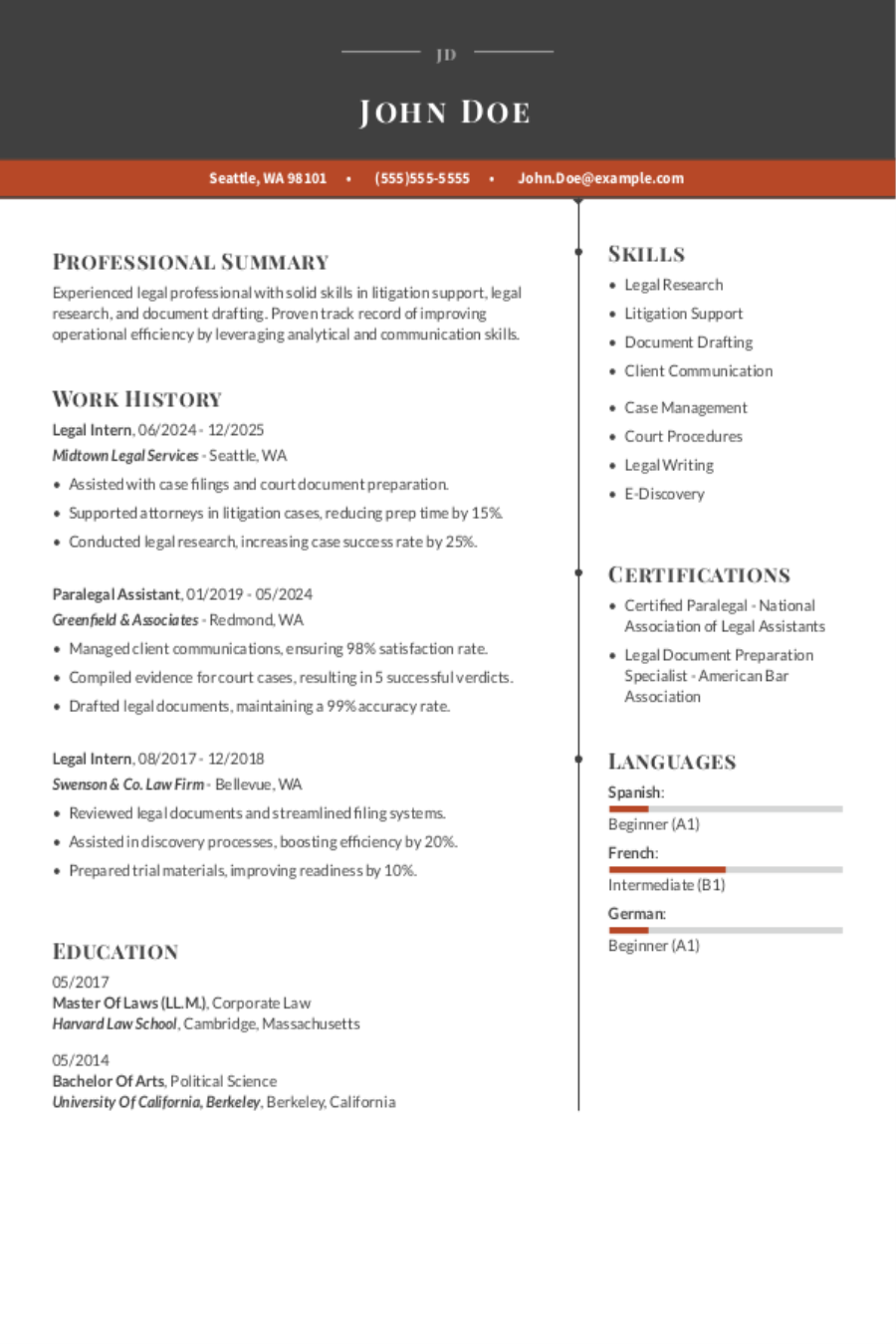A functional resume is a resume format that emphasizes skills and qualifications instead of work history. This format is best for career changers, candidates with long employment gaps, and anyone who lacks workplace experience.
In this article, we cover everything you need to know about functional resume formats, including:
- What is a functional resume?
- Who should use a functional resume format?
- Functional resume examples and template
- Tips for writing an impressive functional resume
- More resources to help you with your resume writing journey
- Functional resume FAQ
Need help creating your resume? Try Resume Now’s AI Resume Builder. Resume Now offers functional resume templates, AI writing assistance, and content suggestions based on your career story.
What Is a Functional Resume?
The functional resume, also called the skills-based resume, is an alternative resume format that showcases skills rather than work experience.
Instead of leading with a list of the jobs you’ve held, a functional resume emphasizes your readiness for the role through a designated skills section. It may also include a deeper summary of qualifications section as well as optional sections for extracurricular activities, volunteer work, relevant hobbies, or academic achievements.
Before we explain who should use the format, check out how this functional resume example is laid out:
Structure of a functional resume


Who Should Use the Functional Resume Format?
You’re probably wondering, “Chronological vs functional resume, which should I choose?”
Recruiters don’t tend to favor functional resumes, so most people should use a chronological or combination format. The chronological resume format focuses on your work history, while the combination resume format tries to balance experience with skills. Both of these formats feature a robust work experience section.
But what if you don’t have professional experience? That’s where the functional resume comes into play.
You should use the functional resume format in your next job application if:
- You have long gaps in your employment. Anyone who has taken extended career breaks may benefit from focusing on skills rather than job history.
- You are changing careers. When switching career fields entirely, highlight your transferable skills with a functional resume. A combination resume format may also be a strong choice in this scenario.
- You recently graduated and have no experience. Without professional experience, you have no choice but to put the spotlight on your skills.
Still not sure if the functional resume is right for you?
Pros and cons of using a functional resume
Pros
- Its summary, qualifications, and accomplishment sections provide ample opportunities to add keywords that appeal to applicant tracking system (ATS) software, which categorizes and parses resumes for relevance.
- It puts pertinent qualifications upfront so hiring managers can see them easily.
- It can hide employment gaps or short employment stints while emphasizing your capabilities.
- It can help you stand out from other job applicants because most don’t use this format.
Cons
- It can be challenging to write. Since you have to show your value through your skills and achievements instead of through your direct work history, you have to think about which skills best describe your abilities.
- Your achievements need to shine right alongside your skills, which requires quantifiable metrics.
- Hiring managers get resumes in this format less often, so it might be difficult for them to review quickly.
- Not all ATS software is set up to scan a functional resume, so it’s crucial to be diligent about using keywords from the job description.
- A lack of experience can’t be covered up completely. Many recruiters look for experience first when reading a resume. A functional resume format is an alternative to a resume that prominently displays experience, but it cannot replace the role that work history typically plays.
Functional Resume Template and Examples
Now that you know the functional resume’s definition and who should use the format, it’s time to focus on examples of functional resumes and get to filling out your resume with an easy-to-download functional resume template.
Free downloadable functional resume template
For help styling your resume, take a look at some entry-level resume samples that demonstrate the strengths of the format.
We have many designs and layouts to choose from. Here’s a functional resume sample you can download for free in Word and fill in your personal information:
Functional resume examples
Once you’ve properly formatted your resume, it’s time to start writing. But where to begin?
Don’t let the blank page bring you down. You’ll find many samples of functional resumes among our resume examples to use as a source of inspiration. The more resumes you review, the more ideas you’ll gather for writing your own.
Use this functional resume example for starters:
If that design doesn’t suit your fancy, that’s okay! Check out functional resume samples in Resume Now’s massive resume template library to find one that does.
How to Write a Functional Resume & Tips for Every Section
While having a visually appealing resume is nice, your candidacy will sink or swim based on your content. Here is some advice for each section of your functional resume.
Tips for writing the header
- Include your portfolio or professional website if you have one.
- Include social media handles if they are relevant to your career.
- Make sure your email address and any relevant social media handles are professional and appropriate for the workplace.
- Triple-check the spelling of your name, email address, and phone number (this mistake is more common than you’d think!).
Tips for writing the professional summary or resume objective
- Keep your summary or objective statement brief (two to three sentences).
- Use action verbs and power words.
- Connect your abilities to the employer’s needs.
- Avoid overused phrases such as “works well independently” or “good communicator.”
Tips for writing the skills section
- Skills are the heart of a functional resume, so don’t hold back.
- Consider breaking your skills into distinct categories to delve deep into them.
- Use the exact words from the job description to make it past the company’s ATS.
Tips for writing the work experience section
- Only include work that’s relevant to your target job.
- Add bullet points if you have specific achievements you’d like to highlight.
- Use quantifiable metrics whenever possible to show the results of your efforts.
Tips for writing the education section
- Include professional certifications if you have any.
- Add any academic awards you’ve received.
- No need to include your graduation dates—they could encourage bias in the hiring process.
Finally, make a good cover letter to complement your resume by finding a matching design in our template library.
FAQ
A functional resume is a format that brings your skills and expertise front and center. This contrasts with a chronological resume, which emphasizes your work history. In the showdown of the functional vs chronological resume, the functional resume format is a good choice for job seekers who lack work experience, as it accentuates the specific skills you can bring to a job, rather than your job history.
The functional resume format is best for candidates who:
- Have never had a job
- Are current college or high school students
- Are applying for a job outside their field or industry
- Have gaps in their employment history
- Have frequently changed jobs
The four types of resumes are:
- Chronological
- Functional
- Combination
- Targeted
We consider the first three—chronological, functional, and combination—to be the core resume types. Each one is a distinct format serving a different purpose. Chronological is the most common. Recruiters love this format because it places work history upfront. Functional is skills-focused, while combination is a balance of the two previous formats.
On the other hand, targeted resumes can be any of the three formats. “Targeted” simply means customizing your resume for every application by including keywords from the job description. We highly recommend customizing your resume for every job.
Focus on your skills and your objectives. Using the employer’s job description as a guide, express what kind of position you want in your summary, and then feature relevant skills in your skills section, paying close attention to the technical abilities the job requires.
If you have specific academic or extracurricular achievements related to the job, include them in your education section or create an “awards and honors” section to feature them if needed. Internships are also valuable to mention, as they prove you know how to handle yourself in a work environment.
Hate is a strong word, but many recruiters are not big fans of the functional format. Recruiters spend about seven seconds glancing over a resume, and they may become impatient if they don’t see any work experience. So, in the battle of chronological resume vs functional, chronological usually comes out on top.
That said, recruiters understand that some candidates, like those still in school or changing industries, don’t have enough work experience to make a traditional resume. Every career has to start somewhere, and a resume with no experience on it is sometimes the only option a candidate has. The functional format allows you to lean into your skills instead of trying to force the chronological format to work without experience.



















